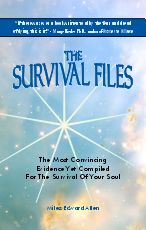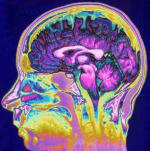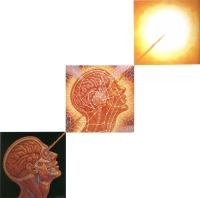The Survival Files
Scientific Evidence of Life After Death
January 2008
 Is there a soul? Is there an afterlife? What about reincarnation? In the spirit of William James and F.W.H. Meyers, Miles Edward Allen provides an overview of scientific evidence for the existence of the soul and its survival of bodily death. Given the ineffable nature of the subject matter, the results are hardly final, though as we will see, they provide a solid introduction and foundation for further exploration.
Is there a soul? Is there an afterlife? What about reincarnation? In the spirit of William James and F.W.H. Meyers, Miles Edward Allen provides an overview of scientific evidence for the existence of the soul and its survival of bodily death. Given the ineffable nature of the subject matter, the results are hardly final, though as we will see, they provide a solid introduction and foundation for further exploration.
Allen’s writing style is clear and precise. He employs a literary technique in which two main characters – the “wise elder” and “student/researcher” – explore twenty three case studies that include phenomena like out-of-body projections, remote viewing, astral bodies, near-death experiences, reincarnation, psi, mediumship, channeling, electronic voice phenomena, and metaphysics. Over a three-day weekend in the mountains of West Virginia, they engage in a well crafted and easy to read Socratic dialogue on the many implications of these phenomena, most of which have been reported throughout human history.
Allen also includes bad guys as a foil – the Überskeptics – who employ an array of tactics, some scientific, and some political, to chronically marginalize decades of legitimate evidence based on the modern scientific paradigm. In the process we discover that the politics and economics of modern science are a juicy, sometimes scandalous affair. Allen does his best to show that the Überskeptics – who are ready to refute, deny, obfuscate all the evidence he presents – have their own political and economic agendas. For instance, is anyone whose show biz name begins with an adjective, like The Amazing Randi, to be taken seriously as a bulwark of scientific clarity and precision? Hardly.
 Yet on the other hand, is it possible to prove through current scientific methods the existence of the soul? Not really. But that’s the bad and good news. As long as we employ the modern materialist, reductionist paradigm – what Ken Wilber calls Flatland – to rationally prove the existence of realities beyond the purview of the five physical senses we will fail. It is impossible, and the Überskeptics will win the day, because they have loaded the deck and limited the playing field to what constitutes valid evidence: five senses-only perception and third-person perspectives (objects, things, its). This, in itself, is not a bad thing. It’s just a very limited approach that ultimately fails every time we try to rationally prove the existence of the soul and its survival of death. I wish Allen had explored this further, and yet, there is plenty of room for a next generation book to tease out these complex and subtle issues.
Yet on the other hand, is it possible to prove through current scientific methods the existence of the soul? Not really. But that’s the bad and good news. As long as we employ the modern materialist, reductionist paradigm – what Ken Wilber calls Flatland – to rationally prove the existence of realities beyond the purview of the five physical senses we will fail. It is impossible, and the Überskeptics will win the day, because they have loaded the deck and limited the playing field to what constitutes valid evidence: five senses-only perception and third-person perspectives (objects, things, its). This, in itself, is not a bad thing. It’s just a very limited approach that ultimately fails every time we try to rationally prove the existence of the soul and its survival of death. I wish Allen had explored this further, and yet, there is plenty of room for a next generation book to tease out these complex and subtle issues.
What Allen is able to accomplish – the strength of this book – is to provide an overview of compelling research done by educated, well meaning, and competent scientists who have been on the fringes of the mainstream. He provides thought provoking arguments for why certain cases may be stronger or weaker in terms of potential fraud, bad methods, or misinterpreting the data. Pioneers like Raymond Moody, Kenneth Ring, Robert Monroe, Jane Roberts, and many others are included to hint at an emerging postmodern paradigm that can more accurately study something as ineffable as the soul, and as such, show that it exists even though we can’t measure it terms of basic quantum fields using instruments made of quantum fields alone.
In integral terms, most of what is covered is the result of ORANGE and GREEN epistemologies, or ways of knowing. A wider, more integral approach to the subject – a TEAL approach – would show how shamen, sages, and adepts through the millennia have employed various meditation methods with discipline and rigor in a community of peers adequate to that paradigm to produce unequivocal evidence to support the existence of the soul and its survival of bodily death, for example, The Bardo Thodol (mistranslated as The Tibetan Book of the Dead). This is a missed opportunity in this otherwise highly recommended book, namely, to show that there is a scientific method that’s been used for thousands of years that includes what Seth, channeled by Jane Roberts and mentioned repeatedly in the book, called inner senses. These go by different names in different cultures, for example, third eye, second attention, eye of spirit, eye of contemplation, and so on.
 When combined with the five physical senses and mental rational senses, the inner senses provide a more complete way of seeing the soul and its survival of death from first, second, and third-person perspectives. Taken together, this is what Seth calls the high intellect, a superb blend of the three ways of knowing into a new cognitive faculty (which I call hyperception). It is one way to expand the modern scientific paradigm into a more comprehensive and inclusive postmodern paradigm, one that includes the best practices of modern and premodern paradigms. This approach is what William James outlined over a century ago as a “science of the soul” at Harvard. Unfortunately, his vision was derailed by the modern reductionist approaches to consciousness still favored by today’s Überskeptics.
When combined with the five physical senses and mental rational senses, the inner senses provide a more complete way of seeing the soul and its survival of death from first, second, and third-person perspectives. Taken together, this is what Seth calls the high intellect, a superb blend of the three ways of knowing into a new cognitive faculty (which I call hyperception). It is one way to expand the modern scientific paradigm into a more comprehensive and inclusive postmodern paradigm, one that includes the best practices of modern and premodern paradigms. This approach is what William James outlined over a century ago as a “science of the soul” at Harvard. Unfortunately, his vision was derailed by the modern reductionist approaches to consciousness still favored by today’s Überskeptics.
All of which hints at what Seth called Dream-Art Science, something I’ve written about extensively elsewhere – an emerging postmodern science that demands the use of physical, mental, and inner senses to provide a more complete, a more true and less partial understanding of the human body in relation to its soul. In this light, we can begin to better explore the nature of the soul and its survival of bodily death, not based solely on my or some expert’s say-so, but also through our own first-person experience. Still, we are decades, if not centuries, away from this kind of postmodern science on any collective scale, and books like The Survival Files provide an accessible introduction to the many issues involved.
We also begin to see that the Überskeptics, who really aren’t bad guys, have simply made careers and a lot of money playing the foil to bad science and metaphysical claims that can’t be justified through conventional, five senses only methods. They are actually correct in many cases and show that the science or conclusions drawn from a particular study have flaws. That is good science! So they, too, offer true but partial perspectives, though we can see that only from a wider postmodern worldview. The Überskeptic’s world is thus limited to black and white, true or false, right or wrong-only propositions. There’s no wiggle room, no shades of gray, and thus no room for a pluralism of “true but partial” perspectives and methods.
 To ultimately prove the existence of the soul in unequivocal, bone rattling, completely certain terms we must learn to directly experience ourselves as soul, which is transcendent to our physical bodies. Compelling anecdotal evidence from near-death, out-of-body experiencers, etc., are only enough to create solid faith that what others have experienced is real, true, and valid. Ironically, it is the same kind of faith that more religious individuals use to maintain the validity of virgin births, bodily resurrections, parting of seas, and walking on water.
To ultimately prove the existence of the soul in unequivocal, bone rattling, completely certain terms we must learn to directly experience ourselves as soul, which is transcendent to our physical bodies. Compelling anecdotal evidence from near-death, out-of-body experiencers, etc., are only enough to create solid faith that what others have experienced is real, true, and valid. Ironically, it is the same kind of faith that more religious individuals use to maintain the validity of virgin births, bodily resurrections, parting of seas, and walking on water.
However, in integral terms these are two different kinds of faith because they occur at different stages of development; the former is modern ORANGE/GREEN, the latter is premodern AMBER. Thus, faith is not something bad, but only a precursor to direct experience, illumination, and remembrance, which always occurs in first-person terms, not through third-person anecdotes. In this sense, then, we come away with a strong faith that the people in these twenty-three case studies are not all tainted by mental illness, bad science, or outright fraud, but in fact are directly experiencing themselves as soul to some degree. This is an important first step.
Allen also offers interesting metaphysical speculations about the mechanics of death and thereafter from the soul’s perspective. One of the closing chapters provides a “Celestial Q&A” that outlines a roadmap of what one might encounter at death based on the anecdotal evidence. Topics include heaven, hell, guides, teachers, life reviews, karma, reincarnation, suicide, responsibility for life’s action, and more. This is the kind of overview I’d want to provide my children when they begin to ask questions about death and the afterlife.
All in all, The Survival Files outlines enough compelling anecdotal evidence to motivate its reader want to learn more the emerging “science of the soul,” and that Überskeptical obfuscations are not based entirely on legitimate agendas. I highly recommend this book for teenagers and adults who are beginning to explore these important existential issues. While there are no hard and fast conclusions to be made, Allen’s engaging story introduces many issues that need to be addressed before final conclusions can be reached. Ironically, we will all pass through death’s door some day and will learn unequivocally the truth for ourselves. And yet, having an accurate roadmap is highly recommended, and The Survival Files delivers just that.
(Note: this book was originally published under the title Heaven Confirmed: The Most Convincing Evidence Yet Compiled For the Survival of Your Soul.)